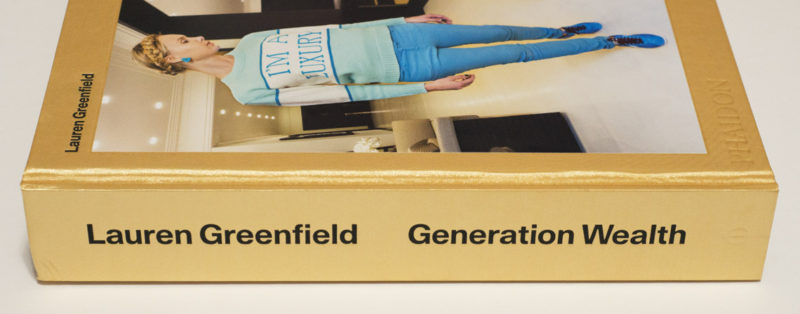Whether I can do Lauren Greenfield‘s Generation Wealth any justice I’m not sure. Its scope is vast, and in these 504 pages it literally tackles it by casting as wide a net as possible. For me, looking and reading through the book has been an utterly exhausting experience; and that’s not a bad thing.
To be clear, what exhausts me is not so much the sheer amount of pictures and text, it’s the spiritual emptiness that sits at the very center of so many of these very aspects presented here. I don’t even consider myself religious. But to encounter such emptiness, such a focus on only one’s own personal gain — that has me exhausted every time I look at the book. So the following paragraphs are more like fragments that somehow hold together (I hope), without necessarily operating in a strict flow.
This is the Age of Trump. The Republican Party has not been subjected to a hostile takeover, as some have claimed. The only hostile aspect of the B-list real-estate developer/celebrity’s takeover was merely not rising through the party’s ranks. In every other aspect, the man himself embodies everything the Republican Party has been promoting for years, albeit in as crude — and open — a fashion as possible. Where people like Paul Ryan pretend they’re interested in the larger good (which they clearly are not), Trump does away with such phony theater. Trump is the Republican Party’s id, and that id is also the driving force behind most of what’s on view in this book.
But it’s too easy to pretend what Generation Wealth shows has anything to do only with one political party. You can find, for example, former Democratic presidential candidate John Kerry in the book. The internet tells me the man’s net worth is a little less than $200m. The privilege is bipartisan. And it goes beyond the US. We have a word for that, globalization. There are many pictures from outside the US in the book, showcasing capitalism and wealth in other countries, whether they’re China, Russia, or wherever else.
It’s too easy to pretend that we photolandians don’t have anything to do with this. For example, on pages 434 and 435 there is a picture of Ilona, “a photographer and former model originally from Latvia” (as the caption informs us). She is seen “in the mezzanine library of her home, which so far contains only copies of a self-published book of her fashion photographs” (ditto). The young woman also graces the cover of the book with her custom-made “I’m a Luxury” sweater.
So yeah, there is some irony in the fact that a book about wealth itself is a luxury object, with gold as the dominant colour on the cover. To pretend, though, that art or the kind of documentary work presented here is not a luxury would be delusional. It is. That fact doesn’t necessarily reduce its larger societal value, but if, and only if, that very fact is being acknowledged. If anything to honestly arrive at that realization is what I feel is still missing in photoland: nobody needs any of these pictures to survive. Nobody.
This doesn’t mean that there isn’t a value in what we do. But that value is not tied to money, even if it is so tempting to talk about the price of things.
Of course, you can get Generation Wealth through your friendly online retailer — see, I’m even providing the link for you. The money will then go to fill the coffers of a US oligarch, even though we have gentler words for these kinds of people here.
We’re all members of a society that has adopted the system laid out in full glory here. As these members we can’t necessarily escape that easily. On page 405, a man named Jeff is depicted camping out during Occupy Wall Street. He’s wearing “a $250 Gucci baseball cap he purchased during the boom years” (again, that’s quoting the caption). A few pages later, there’s a picture that among other people includes Eugenia Kuyda (Russia) who “launched Bribr, a website and app that collects anonymous reports of bribes users have been forced to pay corrupt officials” (ditto). Commodify your dissent. Maybe in these tech crazy years, instead of “commodify” we have another term for that now. .
As I already said, there is a very wide net cast in the book. Here are just some of the chapter titles: “I Shop Therefore I am,” “Sexual Capital,” “Old Money,” “Dream Home,” “Bling Dynasty and New Oligarchy.” In her foreword, the photographer lays out her goal, and it’s important to be aware of this: “The title of the project and many of the pictures could mislead the reader to think that this is a work about the 1 percent […]. It is not. The work is about the aspiration for wealth and how that has become a driving force […] for individuals from all classes of society.” (my emphasis)
In other words: We are the 99 percent — but we want to belong to the 1 percent. The book tries hard to have us arrive at that realization.
Lauren Greenfield devoted over two decades of her life working on all these different angles presented here. And now it’s all here for us to see and to come to our own conclusions. Whatever these conclusions will be, we can’t say any longer that we didn’t know — or didn’t think about it.
Required reading for the Age of Trump (and beyond).
Generation Wealth; photographs by Lauren Greenfield; text by Lauren Greenfield, Juliet Schor, Trudy Wilner Stack; 504 pages; Phaidon; 2017
Rating: Photography 3.0, Book Concept 4.0, Edit 3.0, Production 4.0 – Overall 3.5
Ratings explained here.
